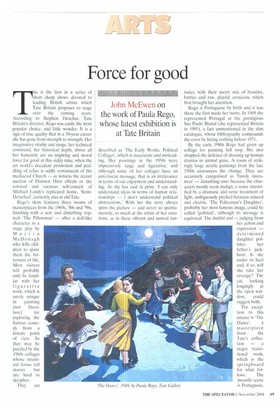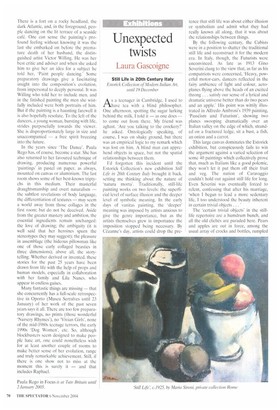Force for good
John McEwen on the work of Paula Rego, whose latest exhibition is at Tate Britain
This is the first in a series of short sharp shows devoted to leading British artists which Tate Britain proposes to stage over the coming years. According to Stephen Deuchar, Tate Britain's director, Rego was easily the most popular choice, and little wonder. It is a sign of true quality that in a 50-year career she has gone from strength to strength. Her imaginative vitality and range, her technical command, tier historical depth, above all her humanity are an inspiring and moral force for good at this sickly time, when the art world's decadent promotion and peddling of relics is oddly reminiscent of the mediaeval Church — as witness the recent auction of Damien Hirst effects or the colossal and vacuous self-conceit of Michael Landy's replicated home, 'SemiDetached', currently also at old Tate.
Rego's show features three rooms of masterpieces from the 1960s, '80s and '90s, finishing with a new and disturbing triptych The Piflown-Ian' — after a doll-like character in a stage play by Martin McDonagh who kills children to spare them the bitterness of life. Most visitors will probably only be familiar with her figurative work, which is surely unique
in painting (not litera ture) for exploring the human comedy from a female point of view. So they may be puzzled by the 1960s collages whose intestinal forms tell stories but are hard to decipher.
They are described as The Early Works: Political Collages', which is inaccurate and misleading. Her paintings in the 1950s were impressively large and figurative; and although some of her collages have an anti-fascist message, that is an irrelevance in terms of our enjoyment and understanding. As she has said in print, 'I can only understand ideas in terms of human relationships — I don't understand political abstractions.' With her the story always spins the picture — and never so spontaneously, so much at the whim of her emotions, as in these vibrant and surreal fan tasies, with their merry mix of beasties, battles and raw, playful eroticism, which first brought her attention.
Rego is Portuguese by birth and it was there she first made her name. In 1969 she represented Portugal at the prestigious Sao Paulo Bienal (she represented Britain in 1985), a fact unmentioned in the slim catalogue, whose bibliography compounds the error by listing nothing before 1971.
By the early 1980s Rego had given up collage for painting full stop. She also dropped the defence of dressing up human dramas in animal guise. A room of strikingly large acrylic paintings from the late 1980s announces the change. They are accurately categorised as 'family narratives' — disturbing ones because the characters mostly seem malign; a sense intensified by a dramatic and eerie treatment of light, ambiguously pitched between natural and electric. 'The Policeman's Daughter', probably her most famous image, could be called 'political', although its message is equivocal. The dutiful and — judging from her action and expression — determ in e d daughter pol ishes her father's jackboot. Is she under its heel and, if so, will she take her revenge? The cat, looking longingly at the open window, could suggest both.
The exception to this unease is 'The Dance', a masterpiece from the Tate's collection — a major transitional work, which is the springboard for what fol lows. The moonlit scene is Portuguese. There is a fort on a rocky headland, the dark Atlantic, and, in the foreground, people dancing on the lit terrace of a seaside cafe. One can sense the painting's profound feeling without knowing it was the last she embarked on before the premature death of her husband, the distinguished artist Victor Willing. He was her best critic and adviser and when she asked him to give her an idea for a subject he told her, 'Paint people dancing.' Some preparatory drawings give a fascinating insight into the composition's evolution, from impersonal to deeply personal. It was Willing who told her to include men, and in the finished painting the men she wistfully included were both portraits of him. But if the painting is a haunting farewell it is also hopefully resolute. To the left of the dancers, a young woman, bursting with life, strides purposefully towards the viewer. She is disproportionately large in size and unaccompanied — a free spirit breezing into the future.
In the years since 'The Dance', Paula Rego has, of course, become a star. She has also returned to her favoured technique of drawing, producing numerous powerful 'paintings' in pastel on paper, as always, mounted on canvas or aluminium. The last room shows some of her best-known triptychs in this medium. Their masterful draughtsmanship and overt naturalism — the subtlest revelations of body language, the differentiation of textures — may seem a world away from those collages in the first room; hut do not be deceived. Aside from the greater mastery and ambition, the essential ingredients remain unchanged: the love of drawing; the ambiguity (it is well said that her heroines spurn the stereotypes they may suggest); the pleasure in assemblage (the hideous pillownnan like one of those early collaged beasties in three dimensions); above all, the storytelling. Whether derived or invented, these stories for the past 25 years have been drawn from life with the help of props and human models, especially in collaboration with her family and Lila Nunes, who appear in endless guises.
Many fantastic things are missing — that she concurrently has a full-scale retrospective in Oporto (Museu SerraIves until 23 January) of her work of the past seven years says it all. There are too few preparatory drawings, no prints (those wonderful 'Nursery Rhymes'), no 'Vivian Girls', none of the mid-1980s teenage terrors, the early 1990s 'Dog Women', etc. So, although blockbusters seem designed to make people hate art, one could nonetheless wish for at least another couple of rooms to make better sense of her evolution, range and truly remarkable achievement. Still, if there is one show not to miss at the moment this is surely it — and that includes Raphael.
Paula Rego in Focus is at Tate Britain until 2 January 2005.



























































































































 Previous page
Previous page